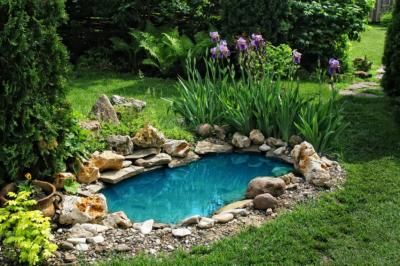Categories
Calendars
Guides
Reviews
Archive
Gallery
Articles
Ask Our Gardening Expert
Pond Construction
The materials were heavy and required a high degree of skill to use. Excavations were large to take into account the quantities of materials needed. The use of plastics and fibreglass has now become widespread and it is much easier to install a pond yourself and create a more natural setting.
Pond materials and size are determined by garden style and size, construction methods and budget. The simplest and cheapest pond is a hole dug to reach the clay layer below the topsoil. If there is no clay layer, lining the hole with the heavy duty black polythene as used by builders will make a pond that will last some years. Commonly used materials include clay, a variety of flexible liners, preformed mouldings and concrete. Each has its merits and disadvantages.
Clay
In heavy clay areas, a pond can be created by simply digging a hole to reach the clay subsoil. To raise the water level to the level of the surrounding ground, the sides of the hole can be packed with compacted excavated clay in successive layers. A layer of topsoil is added to help the water clear or gypsum can be added to clump the clay particles which then sink to the bottom. Such a pond requires no additional materials but needs a large input of labour.
Liners
Most new ponds are formed from flexible liners. A sheet of synthetic butyl rubber, PVC or polythene simply lines the excavated hole to form a waterproof barrier. Liners can be bought in various sizes and shaped to fit any feature from the smallest pool to large ponds. Polythene is the cheapest of materials but is easily ripped and breaks down in sunlight. It is especially useful in shady areas and for bog gardens where it is covered by soil and plants. PVC is much stronger and can last more than twenty years. They may harden and crack after long exposure to sunlight but can be easily covered with sand and stones. Black is the most popular colour and appears most natural. Butyl rubber is by far the strongest, lasting forty years or more, but is the most expensive. It is tough, pliable, difficult to tear and unaffected by temperature extremes.
Preformed Pools
Preformed pools are made of fibreglass, fibrous cement or plastic. They are easiest to install. They come in a variety of shapes and sizes and are often provided with ledges for marginal plants. They are more expensive than liners but are more durable and less likely to be punctured. Their rim must be perfectly level and the excavation, as much as possible, should match the shape of the moulding.
Concrete
Concrete is the best material for formal ponds and suitable for ponds of any size. Construction requires a high degree of skill. In cold climates, ponds sides should be built at a slope so ice can move upwards without causing damage. An area of deep water will be appreciated by fish.
Man mad ponds were formerly made of builder’s materials, stone, brick and concrete. Installation and maintenance was a major undertaking and not taken lightly.
Good planning is important when constructing a pond. Plan the shape carefully, mark the outline with ground marker and think about the disposal of excavated material. You may be surprised by the volumes of soil that need to be removed and the difficulties encountered in digging by hand. A hired digger and driver can carry out a lot of work in an hour or two.